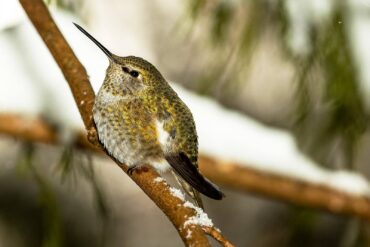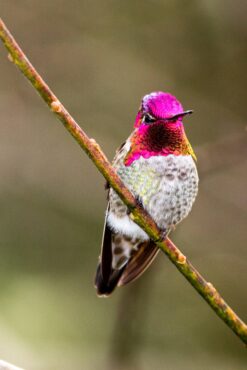
Everyone loves hummingbirds. Even people with little interest in other species are captivated by tiny birds that run on sugar and fly forward, backward, up and down and from side to side, and can hover like a helicopter — the only birds with such aerial abilities.
Despite their diminutive size, hummingbirds are fiercely aggressive, attacking each other like tiny fighter jets in defense of feeding territories. Birders joke that football teams should adopt hummingbirds as mascots, yet somehow the idea has yet to catch on in the sports world.
Hummingbirds have an extremely fast metabolism. To meet their energy needs, they must feed several times per hour, consuming half their body weight each day in nectar. Their hearts beat over 1,200 times a minute while flying and about 250-500 times a minute while at rest. When hovering, the wings beat more than 60 times a second.
There are over 300 species of hummingbirds, all of which live between North and South America. The highest concentration of species surrounds the equator.
In the United States, southeastern Arizona is home to the greatest variety of hummingbirds, with 13 species regularly passing through in migration or staying as year-round residents.

In Washington state, four species of hummingbirds are annual breeders. The rufous hummingbird inhabits the entire state. Black-chinned and calliope hummingbirds nest in Eastern Washington. All three are migratory species that winter in Mexico.
But Washington is home to a fourth hummingbird species that is a bit of an anomaly. Just a few decades ago, the idea of a year-round hummingbird in the Pacific Northwest was unheard of, yet today it’s commonplace.
Until the mid-20th century, the Anna’s hummingbird (named for a 19th-century Italian duchess) rarely ventured north of southern California. But as more nectar-producing plants were planted in gardens, the Anna’s hummingbird began to expand its range northward. By the early 2000s, it had become a common backyard species of the Puget Sound region.
Remarkably, the range of the Anna’s hummingbird now extends from Baja, California, to Arizona, and all along the Pacific Coast, as far north as Anchorage, Alaska.
But unlike the rufous hummingbird that arrives at its upper West Coast breeding grounds by April and departs for its wintering grounds by August, the Anna’s hummingbird stays in Western Washington all year.
The Anna’s can survive a Northwest winter by finding a reliable nectar source, usually a backyard feeder, and also can use sap wells drilled by sapsuckers. The Anna’s has a higher protein diet than migratory hummingbirds. With fewer flying insects available in winter, the Anna’s resourcefully plucks small insects and spiders off plants, like a songbird.
On cold nights, the Anna’s hummingbird enters a near-hibernation state called torpor, in which its normally scorching body temperature of 107 degrees Fahrenheit lowers to 48 degrees and the heart rate slows considerably to 50 beats per minute. When morning comes, its engine quickly revs up and it refuels at a feeding station at daybreak.
Weighing less than a nickel and measuring approximately 4 inches in length, the Anna’s hummingbird is about a quarter inch longer than its cousin, the rufous hummingbird. The male has an iridescent head and throat patch (called a gorget) that is a brilliant magenta in direct sunlight and looks black in indirect light. The female lacks the full colors of the male, but has green spots on her throat. As she matures, she develops a small, rose-colored throat patch within the green spots.
The male Anna’s is known for his spectacular courtship display. He flies high in the air, then plummets toward the ground at 40 mph, pulling up at the last second. As he changes direction, the air rushing through the tail feathers produces a high-pitched popping noise. He makes multiple dives in rapid succession before resting.
Anna’s hummingbirds nest earlier than other hummingbirds, breeding in late winter or early spring. The female is solely responsible for parenting duties and constructs a walnut-sized nest cup of plant material and spider silk.
She lays two eggs that hatch after 16 days. Three weeks later, the hatchlings leave the nest. Their mother tends to them for another week or two before they’re on their own.
Many birds utilize backyard feeding stations to supplement their natural diet but don’t usually depend on them. Anna’s hummingbirds, however, often rely on nectar feeders to sustain them through the winter when few, if any, natural nectar sources are available.
When temperatures dip into the high 20s, bring feeders inside at night, then hang them up again before daylight. If necessary, attach hand warmers to keep them thawed in the daytime.
Year-round hummingbirds are a real treat. The tiny yet feisty Anna’s hummingbird provides endless entertainment as it zips through life in fast-forward. Hang up a feeder and enjoy the show.























Comments